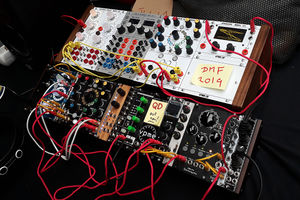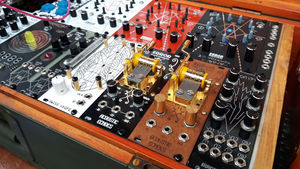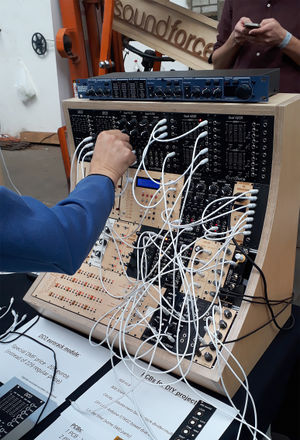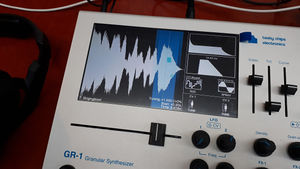User:Markvandenheuvel/specialissue10: Difference between revisions
No edit summary |
No edit summary |
||
| Line 113: | Line 113: | ||
Analog Reel-2-Reel Tape loop interface: | Analog Reel-2-Reel Tape loop interface: | ||
https://www.dutchmodularfest.com/sebastian-scholz | https://www.dutchmodularfest.com/sebastian-scholz | ||
[[File:Modular synth interface.jpg|300px|thumb|none|Pathed Modular Synth Interface]] | |||
[[File:Digital_oscilloscope.gif|300px|thumb|none|Digital oscilloscope]] | |||
[[File:Musicboxmodule.jpg|300px|thumb|none|'Music box to contact mic' module]] | |||
| Line 119: | Line 123: | ||
Protracker: Amiga 8-bit PCM tracker: | Protracker: Amiga 8-bit PCM tracker: | ||
https://www.youtube.com/watch?v=IdbgeFAus0k | https://www.youtube.com/watch?v=IdbgeFAus0k | ||
1-bit music | 1-bit music | ||
Revision as of 19:53, 30 September 2019
SPECIAL ISSUE #10: LFP
Full program and description: http://pzwiki.wdka.nl/mw-mediadesign/index.php?title=Category:LFP
Session 1 with Dennis de Bel
Date: 17-09-2019
Introduction
- modular synthesis: difference between analog & digital modules
- possibilities to patch modules
- the Eurorack format
- how to use modular synth as an interface
- Constructing the 'Meergranen' 8-bit sample module:
- Walk through the components used
- Soldering & testing
- Flashing different presets onto the Arduino Uno
- laser cutting a frontpanel
ideas & thoughts
Possibilities of the project
- synthesizer module as an interface: the cover and connectivitiy to the other modules (interrelationality)
- possibilities and limitations of both software and hardware
- connecting modules augments the possibilites > modularity = Great affordance
links
Basic course in modular synthesizers
Workshop with Olli Aarni at the Player
date: 23 t/m 25-09-2019
pad: https://pad.xpub.nl/p/olliworkshop
Workshop day 1
Listening, discussing sound in relation to linguistics and ways to describe it. "Cognitive linguistics" in relation to sound production. Language as an interface, a tool.
RATELKLONK (also known as a 'klonkie') is a made up word to describe the sound that is produced when a bike lock is chained to a metal object (fence, lamp post, etc)
Workshop day 2
Composing a collection of words (terms, verbs etc.) to talk about sound. What is the difference between the 'official' terminology and subjective methods to describe sound?
Sound categorising exercise
My categories were based on a narrative: A group of people (or entities), a small society performing phycical work or social tasks.
- 1. They did this before. Nothing new… Very little excitement to execute. It's like a routine for them.
- 2. They did it before but it still sometimes excites them unexpectedly. Not too hard! But be aware for unforseen things that definitely are happening.
- 3. These things will always be exciting and can't be done on auto-pilot. Be aware for unexpected things that may be happening.
Somewhat common categories:
- Room + Speech
- Rhythm + Rhythms + Revolving
- Water + Melting
- Surroundings + Environment + Pads and atmos + wood + Trickling
- People + Narrative speculation + Speech
Workshop day 3
Creating sounds for a category of choice with brought objects: Experimenting, Performing, recording.
Sound for speech / dialoque:
- pingpong ball in metal cup > let it bounce on the table while in the cup
- change the cut-off by opening and closing
- try to imitate speech/converstation
- create background noise > roll ball over woorden table while in the cup
Sound for low-frequency kickdrum:
- tune string by stretching > playback at half speed?
final thoughts
What do I want to do with it? How can I create meaningful content "beyond the bleep bleep machine" and how to avoid that the module rules me?
Why do we use a module?? What does it mean?? How is it related to INTERFACE?
In relation to linguistics
- direction of sound (m inwards, s outwards)
- letters that can or can't control tonality (M vs S)
- Meaning in individual letters and structure of language
ideas & references
- Tokyo station names converted to sound: physical place in sound in case a commuter is not able to read the station names
- The concept of invisible people (components) working for you inside a black box. What are 'they' doing for you? How to create awareness (or not?)
- digital speech synthesis, making kind of working noises (that appear in the workplace)
- laquer cut technique > field recordings cut directly into vinyl. This was also used as a communication tool; audio postcard (original or reproduction?)
- transfering data trough sounds (transfered over radio)
resources
https://git.xpub.nl/XPUB/special-issue-x
https://github.com/Eldjotnar/pianotalk
watchlist
INTERFACE: Gordon Monahan - Speaker Swinging
Pendulum Music by Steve Reich
links
Convert .wav to midi
Downloading games from Radio
Speech-to-song illusion
pads
https://pad.xpub.nl/p/olliworkshop
Field trip to Dutch Modular Fest
Gernal definition of Interface: https://www.lexico.com/en/definition/interface
Analog Reel-2-Reel Tape loop interface: https://www.dutchmodularfest.com/sebastian-scholz
Protracker: Amiga 8-bit PCM tracker: https://www.youtube.com/watch?v=IdbgeFAus0k
1-bit music http://www.irrlichtproject.de/houston/index.html





